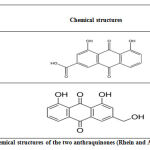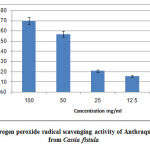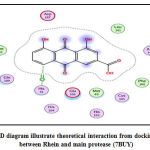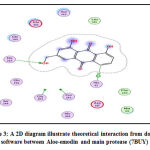Yessar A. Dawood1 , Sabaa Ali Mohammed Al.Fadal1*
, Sabaa Ali Mohammed Al.Fadal1* , Ula M. Noor Almousawi1
, Ula M. Noor Almousawi1  and Murtakab Y Al-Hejjaj2
and Murtakab Y Al-Hejjaj2
1Department of Pharmacognosy and Medicinal Plants, College of Pharmacy, University of Basrah, Basrah, Iraq
2Department of Microbiology and Parasitology, College of Veterinary Medicine, University of Basrah, Basrah, Iraq
Corresponding Author E-mail: sabaaal.fadal@gmail.com
DOI : https://dx.doi.org/10.13005/bpj/2268
Abstract
With the spreading of Covid-19 and seeking for a drug that helps people around the world to cure this disease.In this article, we used a plant(Cassia fistula) which is rich in anthraquinone glycosides to control the causative agent. Anthraquinone was extracted from Cassia fistula pods using alcohol method.Antioxidant activity of the extracted anthraquinone was analysed by using hydrogen peroxide scavenging assay.The best inhibition assay was 70% at100mg/mlconcentration. The docking study introduced atheoretical explanation for an interaction between two types of anthraquinone glycosides (rhein and aloe-emodin) in Cassia fistula against the main protease (7BZ5) in SARS-COV-2 virus, which gave a good binding energy score as -5.36491489 and -5.48040009 for rhein and aloe-emodin, respectively.
Keywords
Anthraquinone glycoside; Aloe-emodin; Cassia fistula; COVID-19; Rhein
Download this article as:| Copy the following to cite this article: Dawood Y. A, Al.Fadal S. A. M, Almousawi U. M. N, Al-Hejjaj M. Y. Antioxidant Activity and In-Silico Study of Anthraquinone Glycosides Extracted from Cassia Fistula Against the Main Protease (7BUY) In SARS-COV2. Biomed Pharmacol J 2021;14(3). |
| Copy the following to cite this URL: Dawood Y. A, Al.Fadal S. A. M, Almousawi U. M. N, Al-Hejjaj M. Y. Antioxidant Activity and In-Silico Study of Anthraquinone Glycosides Extracted from Cassia Fistula Against the Main Protease (7BUY) In SARS-COV2. Biomed Pharmacol J 2021;14(3). Available from: https://bit.ly/3ESEi9Z |
Introduction
The widely Spread of SARS-COV-2 virusinfectionsaround the world, considered as a significant issue, led to a collapse in the health and economic systems. This crisis shows a vital needtodiscover drugs orinnovatevaccines (such as sinopharm, AstraZeneca and Pfizer) in order to control this disease. Medicinal plants form themain componentfor many drugs used beforeto cureseveral diseases for decades.The term of medicinal plants includes various types of plants used in herbalism.Some plants consider asan important source of nutrition and as a result of that, these plants recommended for their therapeutic values(Rasool Hassan 2012).Cassia fistula Linn. underthe Fabaceae family is native to southern Asia but now widely grown in tropical and subtropical areas as an ornament plant due to its beautiful bright yellow flowers. It has some other vernacular names include golden shower, Indian larburnum, and pudding pine tree. C. fistula, a national tree of Thailand, is also known as ratchaphruek or Khun inThai.C. fistula pod pulp is widely used in traditional medicines as a purgative/laxative drug and also used against various disorders such as skin diseases, diabetes, and other ailments (Chewchinda, Wuthi-Udomlert, and Gritsanapan 2013).The pods and leaves of this plant are rich inanthraquinone glycosides, rhein and aloe-emoedin are the most important anthraquinone in this plant, these compounds consist ofglycon and aglycon part hydrolyzed byβ-glucosides of the intestinal flora. Anthraquinone glycosides possess more potent biologicalactivity than the free aglycones (Sakulpanich and Gritsanapan 2009). In addition to this activity,anthraquinone glycosides have another applications in analytical chemistry due to their ability to undergo reversible reactions, conferred by electrophilic character of most of these compounds, and there optical properties, which are directly to their nature and position of substituents and intramolecular and intermolecular interactions, such as hydrogen bonds(Diaz-Muñoz et al. 2018).In this research,antioxidant activity and In-silico study ofrhein and aloe-emodin (extracted from Cassia fistula) against (7BZ5) which is protein SARS-COV2 viruswere studied.
Materials and Methods
Plant collection
Plant pulps were collected from the localIraqi market then grindto a fine powder by anelectric mill.
Isolation of anthraquinones glycosides
The extraction process was carried onaccording to (Sakulpanich and Gritsanapan 2008). 10 gmplant powder was maceratedwith70% ethanol. The maceration extract wasfiltered and evaporated to dryness. Then the crude extract was refluxedby using 70% ethanol for 15 min. After cooling the extract, H2O was added to the mixture and centrifuged for 10 min at 4000 rpm.The supernatant was isolated in a clean flask, then 20 ml of 10.5% FeCl36H2O was added and refluxed for 20 min, followed by adding 1 ml of HCl and 25 ml ether.Next, the ether layer was isolated and washed with 30 ml H2O, then adjust to 100 ml with ether and evaporated to dryness.
Hydrogen peroxide scavenging assay
The ability of anthraquinone glycosides extract to scavenge hydrogen peroxide was determined according to the method described by Sasikumar (2014). Briefly, 43 mM hydrogen peroxide solution was prepared in phosphate buffer (1 M pH 7.4). Different concentrations of sample (100-10 mg/ml) were added to a hydrogen peroxide solution (0.6 ml, 43 mM). The absorbance of hydrogen peroxide at 230 nm was estimated after 10 minutes against a blank solution containing phosphate buffer only(without hydrogen peroxide). Ascorbic acid was used as a standard. Finally, the free radical scavenging was determined by evaluating the % inhibition.
Docking study for rhein and aloe-emodin against spike protein (7BZ5) and main protease (7BUY) in COVID-19 virus:
In this study, two anthraquinone glycosides abundant in Cassia fasitula were chosen (Rhein and Aloe-emodin)(Naresh et al. 2018). The three-dimensional structures of the main protease (7BUY) in COVID-19 was downloaded from Protein Data Bank(Jin et al. 2020).The crystallographic properties illustrated in Table 1. Table 2 shows the chemical structure forrhein and aloe-emodin. The Molecular Operating Environment (MOE software) was used for the docking study.The energy for each protein was minimised,and (Amber 10) used as force field energy. Then, the suitable active site was detected for docking with selected anthraquinone glycosides, which download as SDF formate from PubChem. Lipinski’s physicochemical parameters rule for each selected anthraquinone glycosides showed in Table 3 (Bouchentouf and Missoum 2020).
Table 1: Crystallographic properties of S1protein(7BZ5) and Main protease
| Protein and enzyme | PDB Code | Classification | Expression system | Resolution | Method | Total structure weight (kDa) | chain |
| COVID-19 Main protease | 7BUY | Viral protein | Escherichia coli Bl21 (DE3) | 1.60 Å | X-RAY DIFFRACTION | 34.36 | A |
 |
Table 2: Chemical structures of the two anthraquinones (Rhein and Aloe-emodin). |
Table 3: Lipinski’s physicochemical parameter for Rhein and Aloe-emodin
| Compounds | Mol. Weight g/mol | h_logP | h_logS | a_acc | a_don | TPSA (A°) | b_rotN | lip_druglike |
| Rhein | 284.2230 | 2.4404 | -3.7005 | 6 | 4 | 111.900 | 1 | 1 |
| Aloe-emodin | 270.2400 | 2.4270 | -3.4443 | 5 | 3 | 94.8300 | 1 | 1 |
Results
Hydrogen peroxide scavenging assay
The scavenging ability of anthraquinone glycosides in hydrogen peroxide is shown in (Fig. 1).The result identified that the highest inhibition percentage was70.1% belongs to 100mg/ml concentration of anthraquinone, and IC50 of anthraquinone extract from Cassia fistula was 61.8% Figure 1.
 |
Figure 1: Hydrogen peroxide radical scavenging activity of Anthraquinone extract from Cassia fistula |
Molecular docking studies
From five poses by (MOE software) in each docking for rhein and aloe-emodin, one confirmation was chosenaccording to the bestbinding energy score and the suitable interaction with the selected protein active site. Table 4 illustrate obtained score for each selected anthraquinone. While figure 2 illustrate a 2D diagram for interaction between rhein and the main protease (7BUY), which showed one hydrogen interaction possible between carbon-17in the ligand (Rhein) and receptor 5-ring histidine (41), H-pi interaction with distance 3.81 and energy -1.0 Kcal/mol. In figure 3, a 2D diagram illustrates the interaction between aloe-emodin and 7BUY protein, which showed two hydrogen interactions possible between oxygen-5 in the ligand (aloe-emodin) and receptor amino acid histidin (163), H-acceptor with distance 3.29 and energy -0.6 Kcal/mol. The second hydrogen interaction was estimated between carbon-17in the ligand (aloe-emodin) and receptor 5-ring histidine (41), H-pi with distance 3.81 and energy -1.0 Kcal/mol.
Table 4: Obtained docking score by anthraquinone glycosides from Cassia fsitula with 7BUY
| Anthraquinone glycosides | Score (Kcal/mol) |
| 7BUY | |
| Rhein | -5.36491489 |
| Aloe-emodin | -5.48040009 |
 |
Figure 2: 2D diagram illustrate theoretical interaction from docking software between Rhein and main protease (7BUY) |
 |
Figure 3: A 2D diagram illustrate theoretical interaction from docking software between Aloe-emodin and main protease (7BUY). |
Cassia fistulais one of the most widespread plants worldwide, especially in India’s forests. The whole plant possesses medicinal properties. The experiments illustrate that leaves of the plant have hepatoprotective activity. At the same time, plant pods have antipyretic activity, plant seeds have anticancer activity, while the antioxidant activity found in leaves, pods and bark(Kumar et al. 2017).The results of the antioxidant activity experiment indicate that the anthraquinone extract contains scavenging activity.This activity explains the number of hydroxy groups in the anthraquinone nucleus, which seems to play anessential role in antioxidant activity.Briefly, the effectiveness of anthraquinones with two or three hydroxy groups was higher than those with no hydroxyl groups, according to the structure of rhein and aloe-emodin which contain three hydroxyl group and that may explain the antioxidant activity of them.This activity of these compounds is the secret behind their antiangiogenic and anticancer activities(Mohammed et al. 2013;Tripathi et al. 2014).For sure, food and plants with antioxidant activity are good choices for human health to prevent the dangerous effect of free radical (Mellado et al. 2013).Since December 2019,SARS-COV-2 virus invasive mostly all the world,finding a vaccine ora drug against this disease an essential issue.One approach to control this crisis is targeting the viral proteins or enzymes to cure this disease. At the same time, there is an apparent lack of laboratory equipment and preventive methods to deal with this virus in many countries worldwide, especially developing countries, in addition to what modern technology offers an intelligent bioinformatics programmes. Thus,this manuscript used a docking technique to illustrate the interaction between the main viral protease and anthraquinone glycosides (Rhein, Aloe-emodin).This enzyme represents one of the most criticaltargets for the antiviral pharmacological actions against COVID-19. It is essential for the virus due to its proteolytic processing of polyproteins. This enzyme is an attractive target because of its vital role in polyproteins processing, that are translated from the viral RNA(Estrada 2020)(Zhang et al. 2020). In silico study showed agood interaction between the two anthraquinones and the main protease (7BUY) with a good score. The research against HIV virus illustrates anthraquinone hasa good antiviral activity because these compounds have hydroxyl group, and the anthraquinone with carboxyl group and without hydroxyl group,its loss antiviral activity while the presence of hydroxyl group give this compounds antiviral activity, and the experiment applied on influenza virus and the aloe-emodin give antiviral activity because its contain thee hydroxyl group and this applied on rhein(Schinazi et al. 1990)(Mohammed et al. 2013). Interestingly, this article represents the first step to use these anthraquinone glycosides against SARS-COV-2 virus.
Conclusion
Cassia fistula pods is a good source for anthraquinone glycosides which have antioxidant activity with an inhibition percentage 70% at (100 mg/ml). This article introduce docking study to explain theoretically the effect of two types of anthraquinone in Cassia fasitula against the main protease in COVID-19 virus which give a good binding energy score for rhein and aloe-emodin.
Acknowledgement
The authors would like to express their heartfelt thanks to the Department of Pharmacognosy and medicinal plants, and the Department of Clinical Laboratory Sciences/ College of Pharmacy/University of Basrah for their assistant and effort during the study.
Conflict of interest
None
References
- Bouchentouf, Salim, and Noureddine Missoum. 2020. “<strong>Identification of Compounds from <em>Nigella Sativa </Em>as New Potential Inhibitors of 2019 Novel Coronasvirus (Covid-19): Molecular Docking Study</Strong>.” (April).
CrossRef - Chewchinda, Savita, Mansuang Wuthi-Udomlert, and Wandee Gritsanapan. 2013. “HPLC Quantitative Analysis of Rhein and Antidermatophytic Activity of Cassia Fistula Pod Pulp Extracts of Various Storage Conditions.” BioMed Research International
CrossRef - Diaz-Muñoz, Gaspar et al. 2018. “Anthraquinones: An Overview.” Studies in Natural Products Chemistry 58(July): 313–38.
CrossRef - Estrada, Ernesto. 2020. “Topological Analysis of SARS CoV-2 Main Protease.” Chaos 30(6).
CrossRef - Jin, Zhenming et al. 2020. “Structural Basis for the Inhibition of SARS-CoV-2 Main Protease by Antineoplastic Drug Carmofur.” Nature Structural and Molecular Biology 27(6): 529–32. http://dx.doi.org/10.1038/s41594-020-0440-6.
CrossRef - Kumar, Ajay, Satish, Ibrahhim Sayeed, and Karunakara Hedge. 2017. “Therapeutic Uses of Cassia Fistula : Review.” International Journal of Pharma And Chemical Research 3(1): 38–43.
- Mellado, Marco et al. 2013. “Antioxidant Activity of Anthraquinones Isolated from Leaves of Muehlenbeckia Hastulata (J.E. SM.) Johnst. (Polygonaceae).” Journal of the Chilean Chemical Society 58(2): 1767–70.
CrossRef - Mohammed, Magdy M. D., Sahar S. El-Souda, Salwa M. El-Hallouty, and Nobuyuki Kobayashi. 2013. “Antiviral and Cytotoxic Activities of Anthraquinones Isolated from Cassia Roxburghii Linn. Leaves.” Herba Polonica 59(4): 33–44.
CrossRef - Naresh, Damuka, Dhammapal Bharne, Paramananda Saikia, and Vaibhav Vindal. 2018. “Anthraquinone Rich Cassia Fistula Pod Extract Induces IFIT1, Antiviral Protein.” Indian Journal of Traditional Knowledge 17(3): 474–79.
- Rasool Hassan, Bassam Abdul. 2012. “Medicinal Plants (Importance and Uses).” Pharmaceutica Analytica Acta 03(10): 2–3.
CrossRef - Sakulpanich, Aurapa, and Wandee Gritsanapan. 2008. “Extraction Method for High Content of Materials and Methods :” 22(4): 167–72.
CrossRef - Sakulpanich, Aurapa, and Wandee Gritsanapan. 2009. “Determination of Anthraquinone Glycoside Content in Cassia Fistula Leaf Extracts for Alternative Source of Laxative Drug.” International journal of biomedical and pharmaceutical sciences 3(1): 42–45.
- Sasikumar, Vadivukkarasi. 2014. “Evaluation of Free Radical Scavenging Activity of Various Leaf Extracts from Kedrostis Foetidissima (Jacq.) Cogn.,.” Biochemistry & Analytical Biochemistry 03(02).
CrossRef - Schinazi, Raymond F. et al. 1990. “Anthraquinones as a New Class of Antiviral Agents against Human Immunodeficiency Virus.” Antiviral Research 13(5): 265–72.
CrossRef - Tripathi, Brijesh et al. 2014. “Potential Antioxidant Anthraquinones Isolated from Rheum Emodi Showing Nematicidal Activity against Meloidogyne Incognita.” Journal of Chemistry
CrossRef - Zhang, Linlin et al. 2020. “Crystal Structure of SARS-CoV-2 Main Protease Provides a Basis for Design of Improved a-Ketoamide Inhibitors.” Science 368(6489): 409–12
CrossRef







